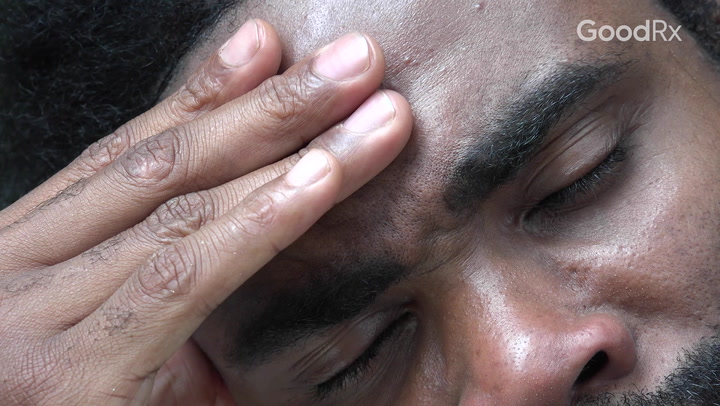
Do You Have Chronic Migraines? Botox Might Help
Key takeaways:
Chronic migraines are a headache syndrome in which people get migraines at least 15 days out of every month.
Treatment for chronic migraines focuses on preventing headaches and avoiding triggers so people can have as many pain-free days as possible.
Botox (onabotulinumtoxinA), which was approved by the FDA for chronic migraine prevention in 2010, can lower the number of migraines people experience.
Access savings on related medications

Migraines are a complex neurological condition. People with migraines experience intense headaches and other symptoms that make it hard to do daily activities like attend work or school. About 15% of adults experience occasional migraines. And each year, about 3% of them develop chronic migraines.
People with chronic migraines experience headaches at least 15 days out of every month, with symptoms lasting at least 4 hours. Imagine spending nearly half your time in pain. It’s no wonder that people with chronic migraines are constantly looking for treatments that can deliver more pain-free days.
Treatment for chronic migraines focuses on three key areas:
Identifying and avoiding migraine triggers
Preventing migraines from starting
Relieving pain once a migraine starts
In 2010, the FDA approved a surprising treatment for preventing chronic migraines: Botox (onabotulinumtoxinA). That’s right — Botox can do a lot more than give you wrinkle-free skin, it can also prevent chronic migraines and give people long-lasting migraine relief.
How does Botox work for chronic migraines?
Botox (onabotulinumtoxinA) works by preventing migraines from starting. The main goal of chronic migraine treatment is to give people more pain-free days. So treatments that prevent migraines are key to keeping migraine attacks as low as possible.
It’s not exactly clear how Botox prevents migraines. Scientists believe it may stop the body from making chemicals that trigger migraines. Botox might also stop nerves from releasing chemicals that transmit the sensation of pain.
Botox is considered a second-line treatment for chronic migraine prevention. That means it’s usually saved for when people don’t do well with first-line prevention treatments like:
Propranolol (Inderal)
Amitriptyline (Elavil)
Topiramate (Topamax)
Valproic acid (Depakene)
About half of people who start a first-line prevention treatment experience 50% fewer headaches after 3 months of treatment. But the other half isn’t so lucky. For these people, adding Botox to their treatment plan can give them more pain-free days and shorter headaches during migraine attacks.
Dr. Olivia Begasse de Dhaem, a neurologist and headache specialist at Hartford Healthcare says Botox works well for her patients.
“About 50% of people respond after the first set of injections, but the effect tends to build up over time with repeated injections,” Begasse de Dhaem says.
What is the success rate of Botox for migraines?
In clinical trials, people who received Botox for chronic migraine prevention had fewer headache days and fewer migraine symptoms after 24 weeks of treatment. In another clinical trial, people who received Botox had 2 fewer migraines days per month than people in the placebo (control) group after 24 weeks of treatment. And people who continued receiving Botox still reported fewer headache days in follow-up studies.
It’s important to point out that while these results were positive, the effects were modest. While groups that received Botox reported, on average, 8 to 9 fewer headaches days, the placebo group reported 6 to 7 days fewer headache days. But researchers and officials at the FDA still considered this a significant difference. So while Botox won’t stop chronic migraines altogether, it can give people more pain-free days.
What is Botox therapy for migraines like?
Botox therapy involves injections (shots), which can be intimidating or even frightening for some people.
During Botox therapy, a trained healthcare provider injects the Botox solution into seven different muscle groups on a person’s:
Forehead
Temples
Back of the head
Upper back
If you feel pain in a particular area during migraines, your healthcare provider may also give you additional injections in these spots.
This adds up to 30 to 40 injections.
The good news is your healthcare provider only needs to use a very small (30 gauge) needle for Botox injections. These needles are much thinner than needles used for blood draws or vaccines. The needle doesn’t have to enter too deeply either. And the amount of fluid injected into each site is also very small. All these things make an injection less painful. So overall, the process may not be as bad as you’d imagine.
Botox injections need to be repeated every 3 months, which can be time-consuming. But in the long run, Botox treatments may save you time and energy, especially if you can take fewer medications to prevent and treat migraines.
Does insurance cover botox for chronic migraine prevention?
Yes. Insurance plans and Medicare will cover Botox for chronic migraine prevention. In fact, Botox is considered a “low-cost option” for chronic migraine treatment because it lowers costs overall by cutting down on the number of visits and medications people need to control their migraines.
But keep in mind that Botox is a second-line treatment for chronic migraine prevention. That means you’ll have to try one or more of the first-line treatments before your insurance will cover Botox.
Also, Botox is only FDA-approved for people older than 18 years old. Children and teens can be treated with Botox “off-label” but insurance may not cover the cost of Botox in these situations.
The FDA recommends 155 units of Botox per treatment. This can cost between $300 and $600. There’s a “Botox Savings Card,” which can help defer some of these costs if your insurance doesn’t cover Botox treatment.
It’s also important to keep in mind that only Botox is FDA-approved for chronic migraine prevention. Other forms of botulism toxin like Dysport (abobotulinumtoxinA) haven’t been studied for chronic migraine prevention and aren’t covered by insurance.
The bottom line
Chronic migraines are painful and debilitating. But there are treatments that can help prevent migraines from starting and give people more headache-free days. Botox (onabotulinumtoxinA) is an FDA-approved treatment for chronic migraine prevention. Botox treatment can give people more pain-free days and can lessen symptoms during migraine attacks. Botox treatment is covered by insurance and Medicare for treatment of chronic migraines.
Why trust our experts?


References
Allergan Pharmaceuticals Ireland. (1989). Botox [package insert].
Aurora, S. K., et al. (2010). OnabotulinumtoxinA for treatment of chronic migraine: results from the double-blind, randomized, placebo-controlled phase of the PREEMPT 1 trial. Cephalalgia.
Becker, W. J. (2020). Botulinum toxin in the treatment of headache. Toxins.
Bigal, M. E., et al. (2008). Acute migraine medications and evolution from episodic to chronic migraine: a longitudinal population-based study. Headache.
Diener, H.C., et al. (2010). OnabotulinumtoxinA for treatment of chronic migraine: results from the double-blind, randomized, placebo-controlled phase of the PREEMPT 2 trial. Cephalalgia.
Herd, C. P., et al. (2018). Botulinum toxins for the prevention of migraine in adults. Cochrane Database of Systematic Reviews.
Lanteri-Minet, M., et al. (2022). Effectiveness of onabotulinumtoxinA (BOTOX®) for the preventive treatment of chronic migraine: A meta-analysis on 10 years of real-world data. Cephalalgia.
Shaterian, N., et al. (2022). Botox (OnabotulinumtoxinA) for treatment of migraine symptoms: A systematic review. Pain Research and Management.

























